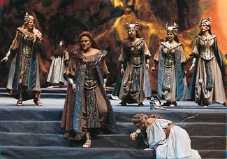Wagner's conception of the music drama
is illustrated most clearly in the "Ring." Its subject matter is
drawn not from legend or fairy tale, but from Norse
mythology; Wagner regarded the myths as suitable not only
because they offer plentiful opportunities for effective theatre but also
because they embody, in a concentrated, poetic fashion, certain philosophical
issues that are of fundamental importance in human life.
The ruling ideal of Wagner's form is the absolute oneness
of drama and music; the two are organically connected expressions
of a single dramatic idea. The action of the drama is considered
to have an inner and an outer aspect; the
former is the province of instrumental music,
that is, of the orchestra, while the sung words
make clear the particular events or situations that are the outer manifestations
of the action.
The music is continuous throughout each
act, not formally divided into recitatives, arias, and other set numbers.
The continuity is not completely unbroken though; broad
scene divisions remain, and within the scenes a distinction is still
evident between recitative-like passages with orchestral punctuation and
others of arioso melody with continuous orchestra. Moreover, the
unfolding of the drama is occasionally interrupted,
or adorned, with interwoven scenes of decidedly operatic character
that are not always strictly necessary to the plot.
Within the general continuity of the action and music, Wagner uses two
principal
means for achieving articulation and formal coherence. The
first
is the leitmotif. Each
leitmotif is a sort of musical label associated with a particular character,
thing, or idea. They recur as "reminders" and gain significance as
they appear in new contexts and combinations throughout the opera.
Different analysts distinguish, and variously name, seventy
to two hundred leitmotifs in the Ring. Only rarely
are the leitmotifs sung. As a rule, the voice will make a
free counterpoint to the instrumental melody. The voice part is,
however, always melodic, never merely declamatory.
Textual repetition is avoided. The melodic
phrases are long and avoid periodic cadential points, so designed that
every note tends to move on without ever quite coming
to rest.
A system of leitmotifs cannot of themselves create musical coherence,
so Wagner utilized a structure of sections or "periods,"
each of which is organized in some recognizable musical
pattern, most often AAB (Bar form) or ABA (ternary arch form; "Bogen" form).
(See also Wagner's
Mature Harmonic Style)
Das Rheingold

The crucible set for the Gods is heated when the forge begins to form
the powerful ring in the underworld of Nibelheim. Wotan bargains with the
Giants to build the glory of Valhalla and risks the Gods' immortality.
To appease the Giants and ensure eternal youth, Wotan steals the Rhinegold
and the ring from the evil dwarf, Alberich and gives it to the Giants.
In fury, Alberich bitterly spits forth the ring's unforgiving curse.
Die Walküre

In the face of the battle, Siegmund, fathered by Wotan, discovers that
Sieglinde is his twin sister. Yet, they join as man and wife.
Wotan knows he must kill Siegmund for the violation of the laws of matrimony.
But unable to bear the agony of the deed, he sends the Valkyrie Brünnhilde,
in his place.
Brünnhilde takes mercy on the two lovers. In anguish, Wotan causes
Siegmund's death by shattering his sword in battle. Brünnhilde is
made mortal as punishment for betraying Wotan, and he surrounds her with
a wall of flame that can only be broken by a hero. A wall of flame. A portent
of the fall of the Gods.
Siegfried

Siegfried, the son of Siegmund and Sieglinde, reforges Nothung, his
father's shattered sword, and kills the dragon guarding the ring.
The ring becomes his, as does the curse. This young man of adventure discovers
the fire containing the sleeping Brünnhilde. He awakens her to love,
and to love's partner: Destiny.
Götterdämmerung

Answering the call to adventure, Siegfried plunges into a world of
false friends, deceit, betrayal and death. An herb potion and deception
by Hagen, the evil dwarf's son, lead Siegfried to force Brünnhilde
into marrying another man.
Hagen ends Siegfried's ring-cursed life with a spear in the back. Siegfried's
funeral pyre and Brünnhilde's immolation ignite the heavens and earth.
The Gods' fate is sealed in the final conflagration and the world awaits
its rebirth.
(Pictures and Synopses from Arizona
Opera)
(See also The Operas and Music Dramas
of Wagner)



